Methods
Study species
The Marsh fritillary butterfly (Euphydryas aurinia) is a threatened grassland butterfly that is protected within the European Union. The species' is on the wing from the end of May to early July. In its larval stage it is monophagous, meaning that it only feeds on one type of plant. In northern Europe their primary host plant is the Devil’s bit scabious (Succisa pratensis). Females oviposit on the host plant, placing egg batches on the underside of the rosette leaves and four weeks later the larvae hatch. Larvae feed and bask gregariously on the host plant during summer and spin a protective silken nest. In September, the larvae enter diapause and spin their autumn nest in which they hibernate together.
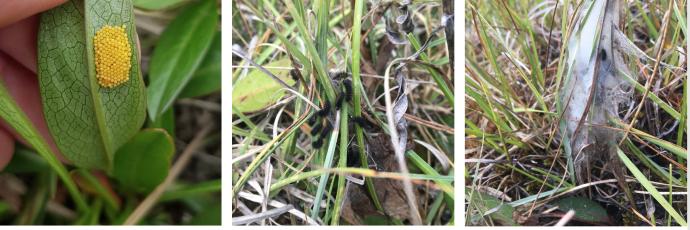
Study area
The study was conducted close to the town of Slite, on the island of Gotland, focusing on the areas Filehajdar and Kallgate. Filehajdar mainly consists of dry, calcareous and nutrient-poor alvar and Kallgate mainly consists of calcareous and nutrient-poor rich fens, of which parts are extensively grazed by cattle ("Kallgate grazed") while one part is fenced off and protected from grazing ("Kallgate ungrazed"). The wetness of both areas may vary across the seasons, with periods of high water levels and periods of extreme drought. Further, overgrowth is slow in both areas due to annual frosts.
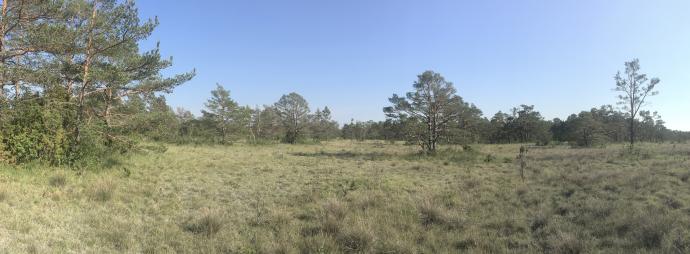
Data collection
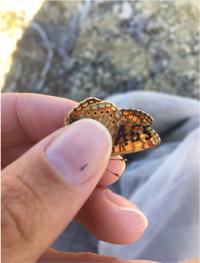
Capture-Mark-Recapture
Adults were captured and marked by using the Capture-Mark-Recapture method. Capturing took place in the area of Filehajdar within 64 one-hectare grid cells. Adults were captured from 9 am to 5 pm on sunny days with an air temperature above 17°C during the flight period (30th May – 27th June 2020). When captured, wings were marked with a unique ID-number. This ID-number, together with date, sex and activity type at the time of capture was all registered. Activity types included: breeding, dead, drinking, egg laying, flying, nectar searching, sitting, sunbathing and other.
Hectare grid survey
To collect adult population data from all three locations, a hectare grid survey was conducted. The survey was carried out sometime between 9 am to 5 pm on sunny days with an air temperature above 17°C. The hectare grid survey was conducted within 21 one-hectare grid cells in Filehajdar and 20 one-hectare grid cells in Kallgate (10 in Kallgate grazed and 10 in Kallgate ungrazed). Suitable habitat for each grid cell was zigzagged through and the total number of observed butterflies, date and visit count was registered. Each grid cell was visited five times between 7th June – 18th June 2020. To avoid bias, the same person would not do the survey on the same location on two consecutive days.
Female host plant choice & Autumn nest and host plant sampling
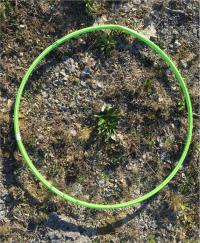
In the Female host plant choice survey, nine one-hectare grid cells were searched for egg batches until at least 10 were found per location. Further, to be able to estimate egg density, six transects per grid cell was searched for egg batches. In the Autumn nest and host plant sampling, all suitable habitat within 71 one-hectare grid cells were searched for larval nests. When an egg batch or a larval nest was found, several environmental variables were registered. For egg batches, with the egg batch in the center, tree crown cover and bush cover in all four directions of a circle with a 1000 cm diameter was estimated. For both egg batches and larval nests, environmental variables within a circle with an 80 cm diameter was registered with the egg batch or larval nest in the center. The variables measured were: tussock occurrence, number of host plants, number of host plant stalks, length of the longest host plant leaf, and more. Furthermore, control points were registered, which were random vegetation points without egg batches or larval nests. The same variables were measured for these points.
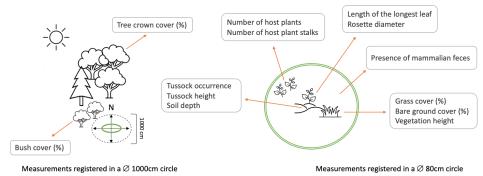
Larval survival
Out of the egg sites that were found in the Female host plant choice survey, 30 were selected and followed over the season with a total of 11 visits. On every visit several variables were registered which included if the larval colony was alive or not, distance moved if they had moved from the point of hatching, presence of parasitic hymenopterans, and more.
National land cover data
Land cover data was downloaded from the Swedish Environmental Protection Agency. Variables that were used for the habitat preference models in this study were: sum of forest and open land cover, mean ground moisture index (“ground moisture”) and object height between 0.5-5 (“bush height”). The data comes in a raster format with 10 m resolution and the smallest possible mapping unit was 0.1 ha, i.e., 10 x 10 m.

Statistical analyzes
To analyze habitat preferences in the different life stages, four Generalized Linear Models (GLM) were constructed. The final models included the variables that generated the lowest AIC-value. First, two Binomial GLMs were created with larval nests occurrence or egg batch occurrence as dependent variables. Further, one GLM with adult density as a dependent variable was created. However, as the adult data was not normally distributed it was log transformed. Furthermore, one negative binomial GLM with larval nest density as a dependent variable was created. For each model, if variables had a correlation coefficient above 0.7, the variable that resulted in the best AIC-value was included. The best model was defined as the model with the lowest AIC-value.
To estimate the population size in Filehajdar from the Capture-Mark-Recapture data, the Craigs Estimator program was used: https://craigestimator.webs.com/.
Analyzes were performed using R, version 3.6.1, with add-on library effects version 4.2-0 for visualizing GLMs.
Responsible for this page:
Director of undergraduate studies Biology
Last updated:
06/08/21
